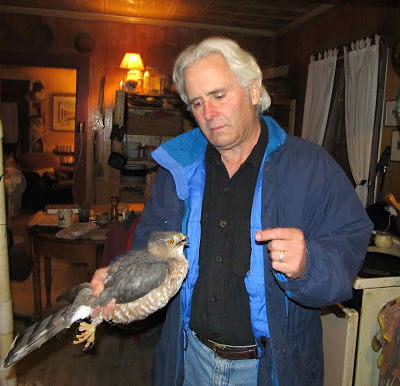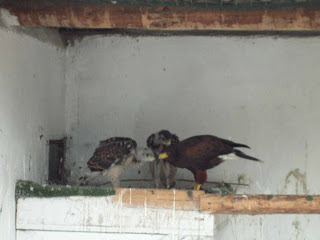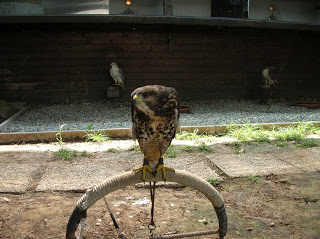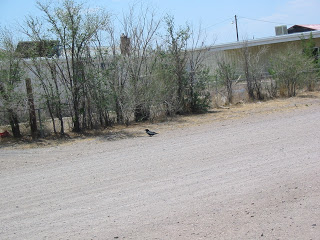Anne Price of the Raptor Education Foundation flies the excellent taiga merlin Tish, who has been drawn by Vadim Gorbatov “bulldogging” a starling (Cowgirl Tish).
We were discussing Cheetah who is half taita (or teita) falcon. The species lives in the river gorges of eastern and southern Africa– I have seen nests near Victoria Falls. Though small it is very stout, broad- shouldered, short- tailed, large- beaked, long- toed, and heavily wing- loaded. It has rusty marks on its head. In fact but for that it is somewhat isolated, and lives near dry forest rather than desert, it could be considered the smallest member of the Barbary falcon (Falco babylonicus) group, the desert “peregrine”– the two subspecies, eastern and western, were once considered races of the peregrine until they were found breeding sympatricly with other races. This species is found from Morocco to western Mongolia, where I have seen THEIR nest sites, the western birds known as Barbary falcons and the eastern as red- naped shahins. The Barbs are little; some rn’s are bigger than peregrines.
Look at the directions evolution has taken small falcons. The teita (a male, very small, about which more in a minute) is a tiny peregrine but stouter; the American aplomado has gone in a direction resembling an Accipiter with a falcon head, long, lanky, long tailed; the merlin is a mini- desert falcon built for swift pursuit.

Second pic: teita, unhappy Tish. Both weigh plus or minus 180 g; “little” Cheetah over 500.

Third: Anne with same. LOOK at proportions!

Fourth, fifth: Red Nape in Almaty Kz breeding project where she dwarfs a male Siberian peregrine– yes, females are bigger but she was huge, though still with those broad shahin shoulders like a teita or Barb. Incidentally they are called Lashyn– my dog’s name– there.


Last, male (I think) rn in Kyrgizstan.

Are the peregrine relatives, probably separated only 12,000 years or so, species or not? Check this scholarly pdf and get back to me…
























